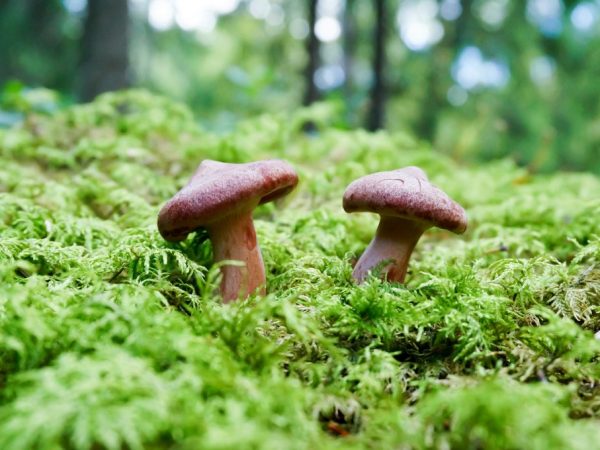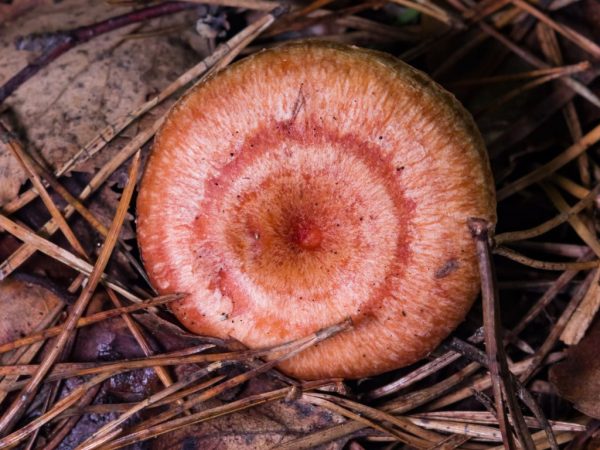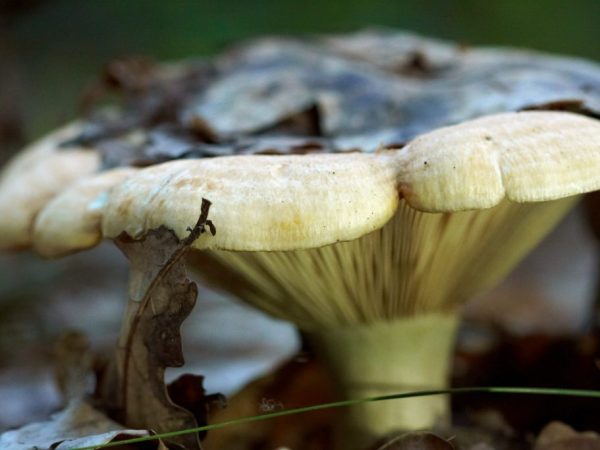Description of false saffron milk caps
False mushrooms are found in nature, but fortunately they are not poisonous. These "mushrooms" are widespread in coniferous forests and are used in saline. To distinguish them from edible mushrooms, you need to know their characteristics.

Description of false saffron milk caps
Amber miller
Other names: gray-pink milky, inedible lactarius, roan lactarius.
Belongs to the lamellar species of mushrooms. It grows in coniferous and mixed forests, where there is a large amount of moss. It enters into a symbiotic union with pines, spruces, sometimes with birch. Loves wetlands. Fruiting from mid-summer to mid-autumn. The largest harvest is harvested in late August - early September.
Appearance
Mushrooms that look like real saffron milk caps still have some differences. In order not to confuse them, it is worth studying the description of the amber milkman.
Hat:
- outstretched at a young age, funnel-shaped at maturity;
- curved at the edges in young specimens and straightened in mature ones;
- with a tubercle in the middle;
- pinkish-brown, sometimes grayish;
- glossy in dry weather.
Leg:
- loose at first, hollow over time;
- cylindrical;
- the color is identical to the color of the cap, but in a lighter tone;
- light shade above, fibrous below;
- up to 2 cm in diameter and up to 9 cm in length.
Pulp:
- light yellow, does not change color when cut;
- thick;
- fragile;
- with watery juice (in adults, juice may be absent).
Plates:
- frequent;
- white, sandy or pink (in the range of a hat);
- dense;
- downstream.
Spores are rounded, reticulate. Spore powder of pink or yellow color.
Nutritional characteristics
Foreign sources define this type of false saffron milk caps as weakly poisonous, domestic sources - as inedible.
It is impossible to eat mushrooms because of the unpleasant (spicy) smell that resembles chicory or lovage. This is the main difference between the amber milky and edible saffron milk caps. The taste is bitter, pungent.
Pink hair

Volnushka prefers wet places
Belongs to the russula family, to the genus Mlechnik. Grows in colonies in birch and mixed forests, in their northern part. Prefers wet areas. Collect it from early summer to mid-autumn. Most mushrooms grow from late July to late August or early September.
Appearance
The characteristics of this false mushroom are slightly different from those of edible mushrooms. The difference is determined by color and some other elements of the appearance.
Hat:
- mucous;
- convex in a young mushroom, flat in an old one;
- with a depression in the center in the form of a navel;
- the edges are lowered, wrapped;
- diameter 4-12 cm;
- with often spaced and thick villi in the form of concentric circles of an uneven shape;
- light or gray-pink;
- darkens upon exposure.
Pulp:
- white, does not change color when notched;
- strong;
- dense;
- juicy.
Leg:
- cylindrical, narrower at the base;
- solid;
- first solid, then hollow;
- light pink;
- with fluff and pits;
- 1-2 cm in diameter, 3-6 cm in height.
Plates:
- white, sometimes with a pink tinge, over time become yellow;
- frequently posted;
- not wide;
- descending along the leg.
Spore powder of cream or white color. According to the description, the mushroom bears similarities to the prickly milky, but the second has no pubescence along the edges of the cap.
Mycorrhiza forms with adult birches. Prefers mixed and deciduous forests as habitats.
Irina Selyutina (Biologist):
There are pink waves in the north of the forest zone. The collection takes place from the end of July to October. The fruiting body contains a toxin, which, in the case of insufficient heat treatment, can cause irritation of the mucous membranes and upset stomach. For salting, young mushrooms, or "curls" with a cap diameter of no more than 3-4 cm, are especially appreciated.
It can also be confused with a white wave, which has a whitish cap and a smaller diameter. The real mushroom and the spruce mushroom have orange juice, while the pink one has white juice.
Nutritional characteristics
False mushroom of this species belongs to conditionally edible mushrooms, therefore it requires careful heat treatment. The taste is spicy. Good quality. Young specimens are especially appreciated. The mushrooms are soaked and blanched before use. Then they are pickled or salted. With the latter method, they are edible only after 50 days. In the workpieces, they become yellow.
Papillary milky

Mushroom smells like coconut
Second name: large milk mushroom. Family russula, genus Mlechnik. Grows in colonies on sandy soils. Distributed in the forests of the northern regions. Creates mycorrhiza with birch. Harvesting takes place at the end of summer - beginning of autumn.
Appearance
False saffron milk caps are distinguished by certain characteristics, most often by color.
Hat:
- flat in adults, with concave edges in juveniles;
- with a tubercle in the center;
- gray or bluish brown, often pinkish or purple in color;
- 3-9 cm in diameter;
- dry, fibrous in old mushrooms.
Leg:
- cylindrical;
- 0.8-2 cm in diameter, 3-7 cm in height;
- hollow in adult milk mushrooms;
- smooth;
- at first light, with time it acquires a shade corresponding to the color of the cap.
Irina Selyutina (Biologist):
If in young mushrooms the cap is characterized by a gray or bluish brown color, then in adult specimens it burns out almost to yellow and becomes dry. The fibers covering it are clearly visible when viewed.
In the leg, the pulp is dense, has a sweetish taste, freshly picked mushrooms have no aroma, but dried ones acquire the smell of coconut. Milky juice is white, not very plentiful. Its color does not change under the influence of atmospheric oxygen. Its taste is sweetish, then spicy up to bitter. Overripe mushrooms are characterized by its complete absence.
Pulp:
- white, changes color when peeled;
- dense;
- fragile;
- thick or thin in certain areas;
- with white juice in small quantities.
Plates:
- frequent;
- whitish-fawn, in adult mushrooms - red;
- narrow;
- descending along the leg.
The spores are rounded. Whitish to gray spore powder.
Nutritional characteristics
Conditionally edible. Eat salted. It tastes bitter, so the milk mushrooms are pre-soaked, otherwise the dish will be spoiled. Has a faint coconut scent.
The mushroom is high-calorie, nutritionally it can replace meat. Vegetarians often include it in their diet. In many foreign sources it has a description characterizing it as an inedible product.
Conclusion
False mushrooms are easy to recognize. If you study the places of their growth, as well as the main characteristics, it will be difficult to confuse them with the real ones.
There are certain rules for their preparation. Without proper processing, the product cannot be eaten, because it will cause poisoning. In case of poisoning, call specialists.


